DisneyToon Studios (2003), Walt Disney Studios Home Entertainment (June 17, 2008), 1 disc, 72 mins plus supplements, 1.66:1 ratio, Dolby Digital 5.1/DTS 5.1, Rated G, Retail: $29.99
One may also wish to read our DVD review of the original release of The Jungle Book 2 here.
Storyboard:
Despite making new friends in the village, Mowgli yearns for the jungle, and so leaves his village to spend time with Baloo.
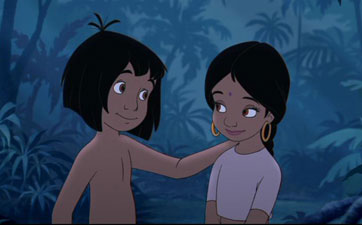
The Sweatbox Review:
Following the unusual decision to release the Peter Pan sequel Return To Neverland into theaters in 2002, Disney decided to do the same for their sequel to 1967’s The Jungle Book the following year. The DisneyToon studios (Tokyo and Australia were involved in this one) had shown themselves extremely capable at making their sequels look amazingly good considering their budgets, which were a fraction of Disney’s other theatrical features. And, with the Neverland film, they managed to come preposterously close to doing a sequel that matched the original in terms of story and animation quality. But did The Jungle Book 2 fair as well? Before answering that, let’s look at the story.

The events of the first movie are first shown in a delightful shadow puppet sequence performed by Mowgli. He shows the people of his new village how he, an orphan living in the Indian jungle, was befriended by a panther and a bear, how he escaped kidnapping by rogue monkeys and the attempted murder by the tiger Shere Khan, and how he eventually ended up living in the human village. Once the performance ends, a tyke named Ranjan reminds everyone that it was the big brown eyes of a little girl named Shanti that enticed Mowgli to follow her into the village. Shanti denies doing so intentionally, but she obviously has a fondness for Mowgli.
She also has her frustrations with Mowgli, who still seems attached to the jungle, constantly telling stories about it sand making it sound fun and exciting. Shanti has learned from the adults, such as her mother or the parents of Ranjan (who function as Mowgli’s adoptive parents) that the jungle is in fact dangerous and is best avoided. One day, when Mowgli gets carried away while singing about the jungle, he begins to lead the village children across the river, which is a forbidden thing. Shanti brings a halt to that, and inadvertently gets Mowgli into trouble. The experience leaves Mowgli convinced that he must return to the jungle and seek out his buddy, Baloo the bear.
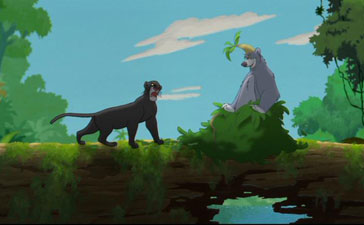
Meanwhile, Baloo is having his own separation anxiety, and faces off against the panther Bagheera and the mighty bumbling of the Colonel Hathi’s elephants in order to reach the man village. Coincidentally, Shere Khan has a similar idea, as he has grown tired of the taunts of other jungle creatures (particularly the loopy buzzards) about how he was humiliated by a small human boy. With a moping Mowgli, Baloo, and Shere Khan all meeting up in the man village, a huge uproar ensues. The end result is that Mowgli finds himself back in the forest, reprising his old adventures.
And that is the main flaw of this movie. So much of it is mirroring the original film, that one wonders why they bothered. Mowgli and Baloo sing Bear Necessities again (one of three times the song is sung in the film!), Mowgli evades Kaa the snake, Baloo and Mowgli return to the monkey city, and once again Mowgli has to face off against Shere Khan. These are certainly familiar story beats if one has seen the first film. Fortunately, there are some important additions as well. There is a significant presence of other human cast members, particularly Shanti and Ranjan, who are looking for Mowgli in the jungle. Ranjan’s parents are also in the jungle, leading the rest of the villagers on the search for the children.
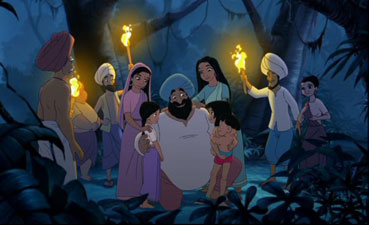
Much of the conflict in the movie is between Shanti and Baloo, or between Baloo and what Shanti represents. Baloo resents that Mowgli finds any appeal at all in the human village, which he sees as boring and not at all fun— not to mention a threat to his own relationship with Mowgli. Shanti’s own feelings mirror Baloo’s, as she resents Mowgli’s attachment to the jungle and his jungle friends. In order for everyone to be happy, all shall have to agree that Mowgli is now a child of both worlds.
In terms of how The Jungle Book 2 looks in terms of quality, the animation is quite fluid and often exceeds the theatrical efforts of lesser studios. There is no doubting that this feature looks brand new, with a larger and more lush color palette, and a lack of Xerox technique-caused scratchiness, compared to the original. Purists don’t want to hear this, but in many ways this movie looks better than the one that inspired it, other than obviously not having the talents of 1967’s Disney animators. Whether or not you appreciate the by the numbers re-do of the plot, this is a bright and beautiful movie. And fortunately (in terms of not straying too far from the original), CGI is used sparingly and tastefully.

I have mixed feelings about this film overall. The finale of this movie somewhat robs the original of its bittersweet ending, though at the same time it does feel like a natural (if overly convenient) evolution of the characters. Still, with so many similarities between the two plots, it is hard to not see The Jungle Book 2 as redundant. And yet… I cannot deny that it was fun to hang out with these characters again. Taken on its own, this is a nice little movie; it just doesn’t stand apart too far from the film that inspired it.

Is This Thing Loaded?
There are lots of bullet points listed on the back cover, but once you take a look at everything, there is not a lot there. There are Sneak Peeks galore, of course— The Suite Life Of Zack & Cody, The Secret Of The Magic Gourd (a Japanese film that Disney is distributing), Phineas And Ferb, The Little Mermaid: Ariel’s Beginning, Tinker Bell, Tim Burton’s The Nightmare Before Christmas, 101 Dalmatians II, Sleeping Beauty, The Sword In The Stone, and Wall*E, plus a promo for the Disney Movie Rewards program.
Moving on to the bonus features, they begin with Deleted Scenes, comprised of two songs and explanations by two of the executive producers. Both songs are presented in storyboard form, with temp singers and music. Although they are both decent (one depicting Mowgli and Shanti’s showdown over preferences for either the jungle of the village; and one about Shanti gathering her courage before entering the jungle), the songs were taken out due to changes made in presenting the character of Shanti.

The “Music And More” section mainly offers karaoke opportunities for the viewer, either via individual song clips from the movie, or while watching the whole film. I’ve never seen how this is much different from just turning on your subtitles, but maybe some kids appreciate these features. There are also three Music Videos, but two are AGAIN just clips from the film (with no subtitles this time— yay), plus a video featuring Smash Mouth doing their rendition of I Wanna Be Like You. Adults may feel free to skip this whole section.
Likewise, the “Games And Activities” section is eminently skip-able, with Mowgli’s Story Time Adventure and Mowgli’s Jungle Ruins Maze likely working better for kiddies than they did for me. (Actually, my daughter found them frustrating to use too.)
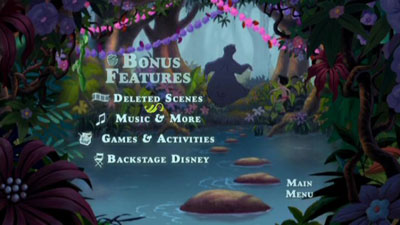
“Backstage Disney” offers a much better selection, as one would expect. Although the Synopsis Of The Original Movie The Jungle Book (2:59) is of limited usefulness, I could see how the narrated montage of clips could help remind younger viewers of what happened in the first movie. Better, though, is The Legacy Of The Jungle Book (14:12), where we meet a number of the production crew on the sequel (mainly Australians), as well as Roy E. Disney and part of the voice cast. This type of featurette is helpful in reminding the sequel haters that the artists working on the film at least have their hearts in the right place.
Unfortunately, no trailer for either Jungle Book film is included.
Case Study:
Standard keepcase, with a foil slipcover. Inserts inside include one for Disney Movie Rewards, one with a chapter listing (with a Sword In The Stone ad on the reverse), and one for Disney Blu-ray.

Ink And Paint:
The 1.66:1 transfer is pretty perfect, nicely showing off the movie’s colourful production design. No significant compression artifacts are seen, and the print is either digital or otherwise free of dirt. It looks like the studios have largely managed to become pretty consistent with DVD transfers by now. Though I’m sure a hi-def transfer would “pop” even more, this standard def presentation is really nice.
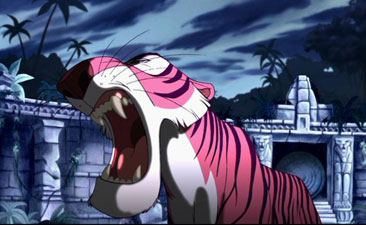
Scratch Tracks:
The 5.1 sound delivers a theatrical quality experience, with lots of enveloping jungle noises and other sound effects. It may not be as impressive as some current big-budget theatricals, but it comes close enough to impress. There are Dolby Digital and DTS options, and overall the DTS is the preferred choice. While there is little difference at times, listening to various passages does reveal that the DTS track is clearer and more distinctly reproduces the soundtrack, especially with deeper timbres, such as Tony Jay’s Shere Khan, or with rumbling waterfalls. The DTS track is much louder during the song Jungle Rhythm, but in most of the other parts of the movie the volumes between the two tracks is much more similar. Spanish and French Dolby Digital 5.1 tracks are also available. There are also subtitles for English, French and Spanish.
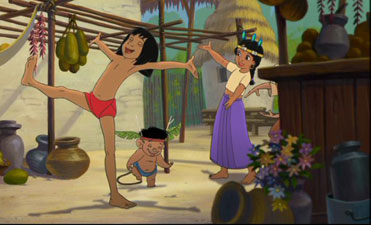
I have to say that I was impressed by the voice work done in this movie. Haley Joel Osment really does quite well as Mowgli, proving to be more than just an act of stunt casting in the wake of Disney’s The Sixth Sense. John Goodman does great as Baloo, but in all honesty no one could have filled the shoes of Phil Harris. Still, Goodman’s demeanor as Baloo does manage to capture a large ampount of the same spirit as what Harris brought to the role, even if their voices are not at all similar. Osment and Goodman also prove quite adept at handling the many songs in the movie. I could have done without all the reprises of Bear Necessities, but there are still a few other original songs that contribute nicely to the Disney song legacy. (I only have a small quibble with the song W-I-L-D, as I doubt that the characters should have been spelling in English, but some things you just have to go with, I suppose.) Other voice talents include Jim Cummings (doing a pretty good Sterling Holloway impression as Kaa, as well as voicing Colonel Hathi), Tony Jay (who also did Shere Khan on TaleSpin), John Rhys-Davies, and Phil Collins (as the new buzzard, Lucky).

Final Cut:
It looks great, sounds pretty good, and hits all the same story beats you loved in the original. Yes, that’s mixed praise, but I think that anyone willing to watch a sequel to The Jungle Book should find this film enjoyable. After all, given that they were doing a sequel, what other story would they be likely to tell? It would have been braver to strike out into whole new territory, but obviously that wasn’t the direction given by the studio heads. So, given the task the artists involved had to perform, I commend them on a very good job. However, if you don’t care to ever see a “redux” version of The Jungle Book, then I doubt you will want to catch this one.
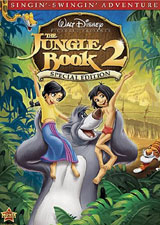 | ||
 |









